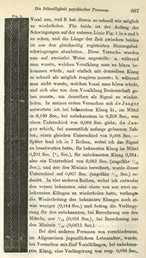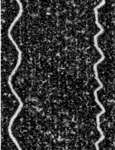"Ki! Ki!":
Franciscus Donders and the Noematachograph
The question: how long does it take a person to respond to a sensory stimulus?
Franciscus Cornelis Donders (1818-1889) of Utrecht University in the Netherlands used the phonautograph to find out—except that he renamed his phonautograph the noematachograph, an "understanding-swiftness-writer."
Here's how the experiment worked. Two subjects sat in front of the recording funnel, and the barrel was set in motion while a tuning fork inscribed a wavy line alongside the test trace. One person then shouted a syllable such as "ki!" The other person was supposed to repeat the syllable as soon as he heard the first person shout it. By counting the number of vibrations the tuning fork had made between the two phonautographically recorded shouts, Donders could tell how long the second person had taken to respond. Sometimes the second person knew in advance what the syllable was going to be, and sometimes he didn't. What Donders wanted to find out was how much longer it took when the second person had not only to repeat the shout, but also to recognize what to shout, an approach now known in cognitive psychology as "Donders' method" or the "subtraction method." The answer: about 0.8 second.
Donders conducted this pioneering experiment in mental chronometry in 1865, and when he published an article about his findings in 1868 (in Dutch, French, and German), he included a sample noematachogram by way of illustration. First Sounds collaborator Patrick Feaster recently tracked down an original print of this plate and made a high-resolution scan which Earl Cornell at Lawrence Berkeley National Laboratory then converted back into sound. The results are combined here into a synchronized stereo file. During the first "play," one track contains the sound of the tuning fork, and the other track contains the two shouts. Next you hear the tuning fork track and the shout track played in sequence. Finally, the two tracks are played together again in stereo. This sound file has not been corrected for speed fluctuations—somehow, Donders managed to achieve a reasonably constant recording speed—but the duration of the recording is adjusted to match his 130.5 Hz (=261 simple vibration) tuning fork.
The voices are scarcely identifiable as voices, and you shouldn't expect to hear a recognizable syllable. Still, Donders' recording gives us an unprecedented opportunity to listen in on a groundbreaking experiment in cognitive psychology from 1865: the tiny delay between the two shouts, played back faithfully in real time from the original inscription.
Listen: Noematachogram, recorded 1865, published 1868 (mp3)

Above: Page from the German version of Donders' 1868 article, showing the noematachogram in context (view larger image)

Above: Detail of the noematachogram. The tuning fork track is on the left, and the shout track is on the right.
For more visual recordings and good stories from this author, see Patrick Feaster's Grammy-nominated Pictures of Sound.
